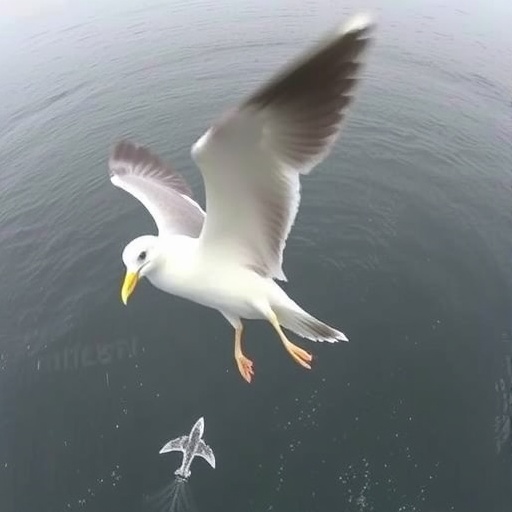In a groundbreaking study capturing the intricate dance between predator and prey in the vast Indian Ocean, scientists have recorded unprecedented on-board footage of red-footed boobies as they skillfully snatch flying fish mid-flight. Utilizing advanced miniaturized bird-borne cameras, researchers have unveiled previously hidden aspects of the foraging behavior of these seabirds, offering fresh insights into their ecological strategies in an increasingly variable climate.
The red-footed booby, a tropical relative of the well-known gannet, was equipped with lightweight cameras meticulously mounted to ensure minimal disturbance to the bird’s natural movements. These devices captured footage of the birds executing incredible aerial feats, gliding just above the water’s surface to intercept flying fish in mid-air. Of fifteen documented attempts to catch prey, an overwhelming majority—fourteen—were aerial catches, highlighting a specialized hunting strategy rarely filmed in such detail.
This research represents the first-ever live visual confirmation of flying fish being captured by seabirds while both predator and prey remain airborne. Previous hypotheses suggested such behavior, but the bird-borne video data provide irrefutable evidence of this dynamic feeding technique. The ability to catch prey mid-flight not only underscores the agility and precision of red-footed boobies but also points to flying fish gliding as a critical ecological link in the marine food web.
Dr. Ruth Dunn, the study’s lead author and a Visiting Researcher at Lancaster University, emphasized the significance of this discovery. She explains that the footage confirms suspicions about their foraging habits, noting, “This evidence reveals that red-footed boobies may derive a substantial portion of their diet from catching flying fish during flight, exploiting a niche where aerial hunting techniques are paramount.” This observation shifts our understanding of how these birds allocate their hunting efforts within their marine environment.
Beyond visual documentation, the research employed sophisticated GPS and accelerometer tracking devices on an additional eighteen birds. These instruments revealed elegant adaptations that enable red-footed boobies to harness wind energy efficiently during long-distance foraging trips. Their wings, characterized by remarkable length and narrowness relative to body size, are anatomically optimized for gliding and soaring in crosswind conditions, reducing energetic costs during commutes across open ocean.
The study found that these birds selectively exploit favorable wind patterns, preferring tailwinds and crosswinds, particularly on outbound journeys to feeding grounds. This behavior allows them to conserve metabolic energy, maintaining high travel speeds without excessive wing flapping. Such energy-efficient flight is crucial given the patchy and transient distribution of their prey within the marine environment, presenting an evolutionary advantage by maximizing search efficiency over extended-ranging flights.
Furthermore, the terrain-less, open ocean foraging niche occupied by red-footed boobies demands flexibility and responsiveness to fluctuating prey distributions. Unlike some seabird species that remain loyal to fixed feeding sites, these boobies demonstrate nomadic hunting patterns, facilitated by their ability to monitor and swiftly respond to shifting environmental conditions. This dynamic foraging ecology underscores the importance of flight mechanics in successful predation and survival.
Importantly, the team observed that red-footed boobies tend to persist in hunting activities under windier conditions, whereas resting behaviors correlate inversely with wind intensity. One plausible explanation is that flying fish, which also rely on wind to prolong their glides above water, become more accessible during stronger wind events. These conditions thereby extend the window during which prey remains exposed and vulnerable to capture, enhancing the boobies’ foraging efficiency.
This finding remarkably contrasts with studies on other pelagic seabirds such as albatrosses, which reportedly face reduced foraging success in high-wind environments. The specialization of red-footed boobies to thrive under fast wind conditions could illustrate an evolutionary trajectory shaped by niche partitioning and resource availability, highlighting the diversity of ecological strategies within marine avifauna.
As global climate change alters atmospheric circulation and intensifies weather patterns, understanding how wind shapes the distribution, behavior, and survival of seabirds like the red-footed booby is both timely and critical. These birds’ reliance on aerodynamic flight adaptations and sensory acumen to exploit fluctuating wind regimes places them at the intersection of marine ecology and climatology, making them sentinel species for environmental change.
Professor Stephen Votier of The Lyell Centre at Heriot-Watt University, co-author of the study, stresses the broader implications: “This research is a foundational step toward predicting how tropical seabirds will respond to shifting wind patterns driven by climate change. Gaining clear mechanistic understanding of wind influence on animal movement will be essential to forecasting future ecological dynamics.”
Supported by the Bertarelli Foundation and involving a collaborative consortium including Lancaster University, Heriot-Watt University, the University of Exeter, and the Zoological Society of London, the study presents a holistic approach to analyzing animal behavior through technological innovation. By integrating direct observation via bird-borne cameras with sophisticated tracking devices, this research stands at the forefront of movement ecology and animal biomechanics.
The full findings are detailed in the peer-reviewed article titled “Commuting in crosswinds and foraging in fast winds: the foraging ecology of a flying fish specialist,” published in the prestigious journal Proceedings of the Royal Society B on August 6, 2025. This work not only enriches our understanding of seabird life history but also raises broader questions about how animals will adapt to ongoing environmental fluctuations.
As we continue to refine biologging technology and data analytics, studies like this herald a new era of ecological research, one where intimate facets of animal behavior unfold from the vantage point of the animals themselves. In doing so, we edge closer to preserving biodiversity and sustaining ecosystems amid an era of unprecedented ecological change.
Subject of Research: Animals
Article Title: Commuting in crosswinds and foraging in fast winds: the foraging ecology of a flying fish specialist
News Publication Date: 6-Aug-2025
Web References: 10.1098/rspb.2025.0774
Image Credits: Dr Ruth Dunn
Keywords: Birds, Ecology, Marine fishes, Climate change, Climate change adaptation, Animal locomotion, Seabirds, Wild birds




